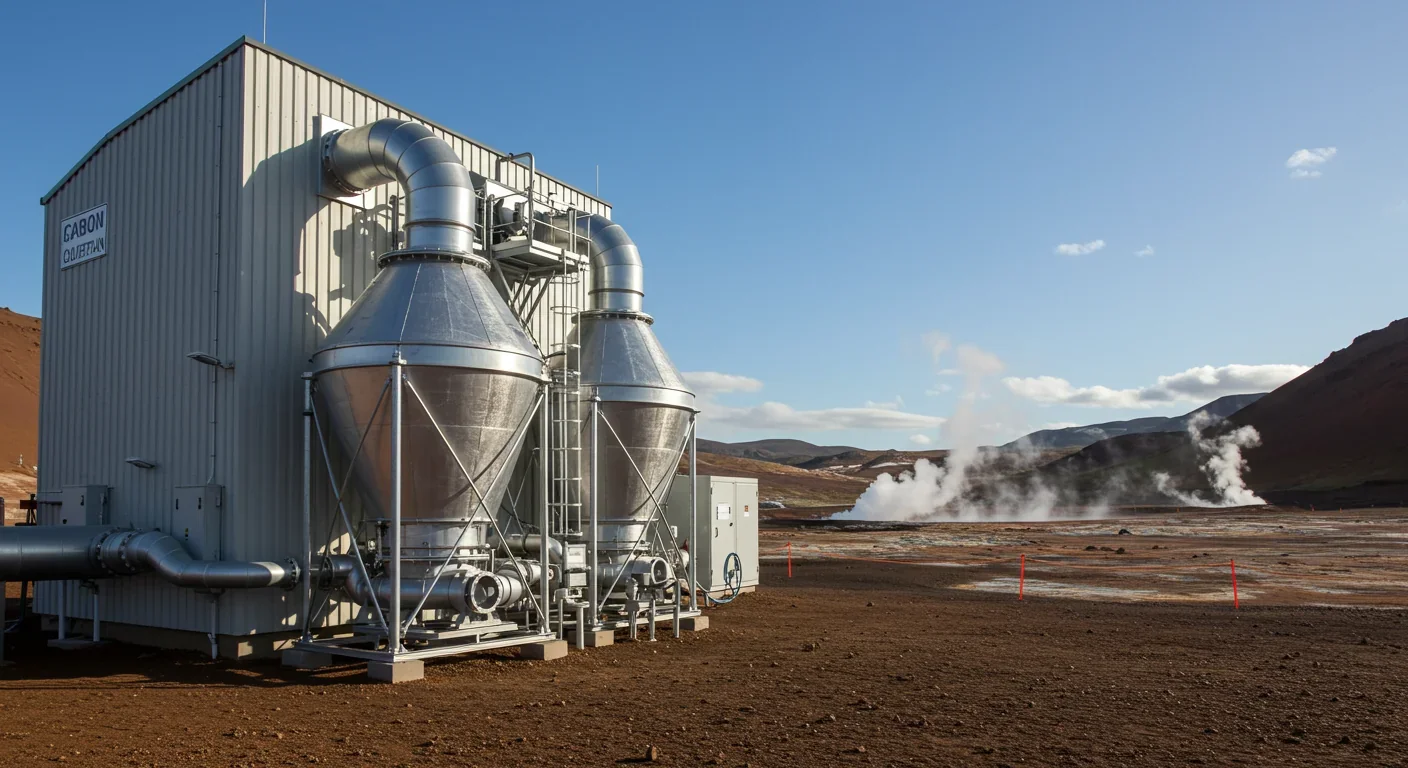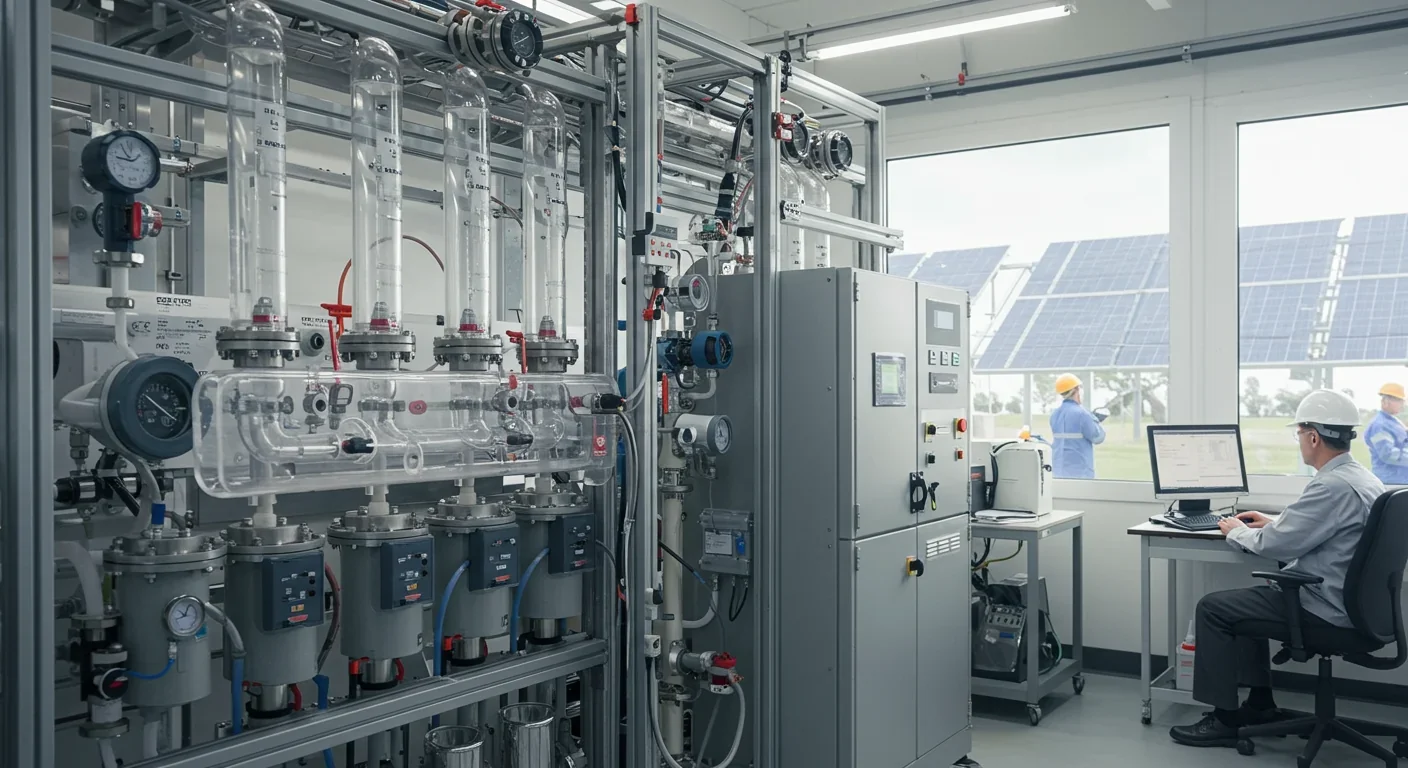Digital Pollution Tax: Can It Save Data Centers?

TL;DR: Direct air capture technology is transforming from science fiction to commercial reality, pulling CO₂ from the atmosphere to create carbon-negative fuels. While costs are falling and deployment is accelerating, DAC remains a critical supplement—not a replacement—for aggressive emissions reductions.

By 2050, climate models predict we'll need to remove between 5 and 10 billion tons of CO₂ from the atmosphere annually just to stay on track for a livable planet. That's roughly equivalent to undoing the emissions of every car, truck, and airplane on Earth—every single year. The challenge seems impossible, until you consider that we're already learning to mine the air itself. Direct air capture (DAC) technology, once dismissed as science fiction, is now pulling carbon dioxide straight from the atmosphere and transforming it into fuel. What was theoretical a decade ago has become operational, and what seemed economically absurd is starting to make business sense.
Think of DAC as a massive, selective sponge. Large fans draw ambient air through chemical filters—solid sorbents or liquid solutions—that bond with CO₂ molecules and nothing else. Once saturated, the filters are heated or subjected to pressure changes, releasing pure CO₂. The process sounds simple, but it's deceptively complex. Unlike capturing emissions at a smokestack where CO₂ concentrations might be 10% or higher, atmospheric CO₂ hovers at just 420 parts per million. You're fishing for molecules in an ocean of nitrogen and oxygen.
Two dominant capture methods have emerged. Solid sorbent systems, like those deployed by Climeworks and GE Vernova, use materials that chemically bond with CO₂ at ambient temperatures and release it when heated. Liquid solvent systems, favored by companies like Carbon Engineering, use a potassium hydroxide solution that reacts with CO₂ to form carbonates, which are then processed at high temperatures to regenerate the solvent and isolate pure CO₂. Each approach has trade-offs—solid sorbents require less water but more complex heating cycles, while liquid systems are energy-intensive but easier to scale.
The real breakthrough isn't just capturing carbon, though. It's what comes next. Through processes like the Fischer-Tropsch synthesis, captured CO₂ can be combined with hydrogen (ideally produced via electrolysis powered by renewables) to create synthetic hydrocarbons—jet fuel, diesel, even gasoline. These aren't biofuels or battery replacements; they're drop-in fuels chemically identical to their fossil counterparts, usable in existing engines without modification. When burned, they release CO₂, but that CO₂ came from the air in the first place. The result? A closed carbon loop, and if the energy powering the entire cycle comes from renewables, you've got carbon-negative fuel.
It's worth noting that renewable energy is essential here. DAC operations integrated with AI-controlled smart grids can optimize when to run capture cycles based on solar and wind availability, slashing costs and ensuring the process doesn't inadvertently add emissions. Without clean power, you're just moving carbon around, not removing it.
If atmospheric mining scales as proponents hope, the implications ripple far beyond climate policy. Consider aviation. Commercial flight accounts for roughly 2.5% of global CO₂ emissions, but there's no clear path to electrify long-haul jets anytime soon. Batteries are too heavy, and hydrogen storage remains impractical for large aircraft. Sustainable aviation fuel (SAF) synthesized from DAC-captured CO₂ could offer a viable bridge—or even a permanent solution. Airlines like Delta and United have already signed offtake agreements for millions of gallons of SAF, betting that regulatory mandates and corporate carbon commitments will make it economically necessary.
The geopolitical angle is just as compelling. Countries without fossil fuel reserves could become energy exporters by building DAC-to-fuel plants powered by abundant solar or wind. Picture Saudi Arabia's role in the oil economy, but flipped: nations with the best renewable resources capture CO₂, synthesize fuel, and sell it globally. This isn't speculative—Climeworks has already deployed a mobile DAC unit in Riyadh to test performance in desert conditions, and Saudi Arabia's Circular Carbon Economy initiative is exploring how to integrate carbon capture into its long-term economic strategy.
On the flip side, incumbent fossil fuel companies are watching closely. Some see DAC as an existential threat, others as an opportunity to rebrand. If synthetic fuels become cost-competitive, the value proposition of drilling for oil weakens dramatically. Why extract finite resources when you can manufacture fuel from air, sun, and water indefinitely? The transition won't be immediate—today's DAC costs are still too high—but the trajectory is clear.

Labor markets will shift too. The oil and gas industry employs millions worldwide, from roughneck crews on rigs to engineers managing refineries. DAC facilities require different skill sets—chemical engineering, renewable energy integration, advanced materials science. Retraining programs will be critical, as will ensuring that communities dependent on fossil fuel extraction aren't left behind. Iceland's Orca plant, for instance, has created local jobs in geothermal energy and carbon storage, but scaling that model globally demands intentional workforce planning.
The most exciting aspect of DAC is its flexibility. Unlike reforestation or soil carbon sequestration, which require specific geographies and decades to mature, DAC plants can be built almost anywhere. You need energy, water, and geological formations for CO₂ storage, but that describes a surprisingly large portion of the planet. Current projections show 27 DAC plants commissioned worldwide, primarily in Europe, North America, and Japan, but the technology's modular nature means deployment can accelerate quickly once costs fall.
And costs are falling. Prometheus Fuels recently announced a breakthrough that slashes DAC expenses by 80%, bringing the price per ton of captured CO₂ closer to $100—a threshold many analysts consider the tipping point for commercial viability. Meanwhile, policy-driven growth is expected to reduce costs by 14% by 2030, driven by economies of scale in manufacturing and improved capture materials.
Corporate commitments are accelerating deployment too. Schneider Electric signed a 31,000-ton carbon removal agreement with Climeworks, reflecting growing demand for verifiable, durable carbon removal. Companies from Microsoft to Stripe are purchasing carbon removal credits, creating a market that incentivizes rapid scaling. Venture capital is flooding in—a $60 billion venture capital alliance recently backed a $300 million fund specifically for climate tech, with DAC as a key focus.
There's also the co-benefit angle. DAC facilities paired with carbon storage can help regions meet net-zero targets without shutting down essential industries. Steel and cement production, which together account for nearly 15% of global emissions, are notoriously hard to decarbonize. DAC offers an offset mechanism that doesn't rely on dubious accounting or forestry credits that might not last a century.
Of course, atmospheric mining isn't a silver bullet, and treating it as one invites disaster. The biggest risk is moral hazard—the idea that because we can remove carbon from the air, we don't need to reduce emissions as aggressively. That logic is dangerous. Even the most optimistic DAC scaling scenarios don't come close to matching current annual emissions. We're emitting roughly 40 billion tons of CO₂ per year; DAC might realistically remove 1 billion tons by 2050 if everything goes right. It's a critical tool, but it can't replace systemic decarbonization.
Energy consumption is another thorny issue. DAC plants require significant power—estimates range from 1,500 to 2,500 kilowatt-hours per ton of CO₂ captured, depending on the technology. If that energy comes from coal or natural gas, you're creating more emissions than you're removing. The entire enterprise hinges on abundant, cheap renewable power. In regions where grids are still fossil-heavy, DAC deployment could backfire.
There's also the water question. Many DAC processes require substantial water for cooling and chemical reactions. In water-scarce regions—exactly the places with the best solar resources—this creates a conflict. Brineworks, a Dutch startup, is developing a seawater-based DAC approach to address this, but it's still early-stage. If DAC scales without solving the water challenge, it could exacerbate existing shortages.
Then there's the equity dimension. Right now, DAC is a technology of the wealthy. The countries and companies investing in it—Iceland, Switzerland, Canada, the U.S.—are not the ones most vulnerable to climate change. If DAC becomes a tool that allows rich nations to buy their way out of climate responsibility while poorer nations suffer the worst impacts, it's hard to call that a success. Ensuring that DAC benefits flow globally, not just to those who can afford the upfront capital, is essential.

And let's not ignore the elephant in the room: synthetic fuel isn't inherently clean. Yes, it closes the carbon loop, but combustion still produces nitrogen oxides and particulates that harm air quality. Cities transitioning to electric vehicles for health reasons won't welcome a resurgence of internal combustion, even if the fuel is carbon-neutral. DAC-to-fuel makes sense for aviation and shipping, where alternatives are scarce, but using it to perpetuate car dependency would be a colossal misstep.
The technology exists; the missing piece is policy architecture that makes deployment economically rational at scale. The U.S. 45Q tax credit offers up to $180 per ton of CO₂ permanently sequestered, creating a financial incentive that's already spurring projects. But tax credits are fragile—they depend on political will, and shifts in administration can jeopardize long-term investments. More durable mechanisms, like carbon pricing or mandates for carbon removal credits tied to fossil fuel sales, could provide the certainty investors need.
Europe is taking a different approach. The EU Innovation Fund has allocated billions for carbon capture projects, and regulations are emerging that require industries to offset a percentage of their emissions with verifiable carbon removal. The Value of Direct Air Carbon Capture report introduces a multi-criteria framework for evaluating CCUS value beyond simple cost—incorporating environmental, economic, and social dimensions. Policymakers in the UK, Australia, and Japan are using similar frameworks to screen where DAC makes sense.
International coordination is critical too. Carbon removal credits only work if they're globally recognized and auditable. The voluntary carbon market has been plagued by fraud and exaggerated claims, eroding trust. Blockchain-based tracking systems, as suggested by AI-enhanced DAC proponents, could offer transparency—every ton captured, transported, and stored would be logged immutably. Whether that's a true solution or just techno-optimism remains to be seen.
Regulatory hurdles also loom large. Where do you store billions of tons of CO₂? Geological sequestration—injecting CO₂ deep underground into porous rock formations—is proven, but it requires extensive site characterization, public acceptance, and long-term monitoring. Communities have pushed back against CO₂ storage projects, fearing leaks or induced seismicity. Transparent risk assessment and benefit-sharing agreements will be essential.
So what does all this mean for you? If you're in energy, engineering, or policy, atmospheric mining is about to reshape your field. Skills in chemical engineering, renewable integration, and lifecycle assessment will be in high demand. If you're an investor, the DAC sector is attracting serious capital—$80 billion in cumulative CCS investments expected over five years—but it's still early and risky. The winners will be companies that crack the cost curve and secure long-term offtake agreements.
For the rest of us, the key is informed skepticism. DAC is promising, but it's not a free pass. Pressure on governments to adopt robust carbon pricing, invest in renewable infrastructure, and enforce emissions reductions remains essential. Atmospheric mining works best as part of a portfolio—aggressive decarbonization, electrification where possible, carbon removal where necessary, and adaptation for impacts we can't avoid.
The good news? We're not starting from zero. The infrastructure is being built, the policies are being tested, and the market is beginning to form. GE Vernova's deployment at Deep Sky Alpha in Canada will capture 1,500 tons per year—a small start, but proof of concept. Climeworks' planned Mammoth project aims for 22,000 tons annually, and future facilities are targeting millions.
Within the next decade, you'll likely see synthetic jet fuel blends become standard, carbon removal credits show up in corporate sustainability reports, and DAC plants dotting landscapes in places you wouldn't expect. The question isn't whether atmospheric mining will happen—it's whether we'll deploy it wisely, equitably, and fast enough to matter.
The air we breathe has always been free. Now we're learning to treat it as both a resource and a repository—a place to mine and a place to store. Whether that shift represents human ingenuity at its best or a dangerous detour from deeper change depends entirely on what we do next.

Recent breakthroughs in fusion technology—including 351,000-gauss magnetic fields, AI-driven plasma diagnostics, and net energy gain at the National Ignition Facility—are transforming fusion propulsion from science fiction to engineering frontier. Scientists now have a realistic pathway to accelerate spacecraft to 10% of light speed, enabling a 43-year journey to Alpha Centauri. While challenges remain in miniaturization, neutron management, and sustained operation, the physics barriers have ...

Epigenetic clocks measure DNA methylation patterns to calculate biological age, which predicts disease risk up to 30 years before symptoms appear. Landmark studies show that accelerated epigenetic aging forecasts cardiovascular disease, diabetes, and neurodegeneration with remarkable accuracy. Lifestyle interventions—Mediterranean diet, structured exercise, quality sleep, stress management—can measurably reverse biological aging, reducing epigenetic age by 1-2 years within months. Commercial ...

Data centers consumed 415 terawatt-hours of electricity in 2024 and will nearly double that by 2030, driven by AI's insatiable energy appetite. Despite tech giants' renewable pledges, actual emissions are up to 662% higher than reported due to accounting loopholes. A digital pollution tax—similar to Europe's carbon border tariff—could finally force the industry to invest in efficiency technologies like liquid cooling, waste heat recovery, and time-matched renewable power, transforming volunta...

Humans are hardwired to see invisible agents—gods, ghosts, conspiracies—thanks to the Hyperactive Agency Detection Device (HADD), an evolutionary survival mechanism that favored false alarms over fatal misses. This cognitive bias, rooted in brain regions like the temporoparietal junction and medial prefrontal cortex, generates religious beliefs, animistic worldviews, and conspiracy theories across all cultures. Understanding HADD doesn't eliminate belief, but it helps us recognize when our pa...

The bombardier beetle has perfected a chemical defense system that human engineers are still trying to replicate: a two-chamber micro-combustion engine that mixes hydroquinone and hydrogen peroxide to create explosive 100°C sprays at up to 500 pulses per second, aimed with 270-degree precision. This tiny insect's biochemical marvel is inspiring revolutionary technologies in aerospace propulsion, pharmaceutical delivery, and fire suppression. By 2030, beetle-inspired systems could position sat...

The U.S. faces a catastrophic care worker shortage driven by poverty-level wages, overwhelming burnout, and systemic undervaluation. With 99% of nursing homes hiring and 9.7 million openings projected by 2034, the crisis threatens patient safety, family stability, and economic productivity. Evidence-based solutions—wage reforms, streamlined training, technology integration, and policy enforcement—exist and work, but require sustained political will and cultural recognition that caregiving is ...

Every major AI model was trained on copyrighted text scraped without permission, triggering billion-dollar lawsuits and forcing a reckoning between innovation and creator rights. The future depends on finding balance between transformative AI development and fair compensation for the people whose work fuels it.